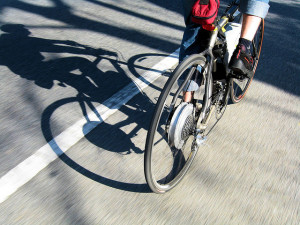Cycling is one of Utah’s favorite sports; that’s one of the reasons we ranked the 8th most bicycle-friendly state in the nation (and 4th in the region) last year, according to the League of American Bicyclists (LAB).
At this year’s Utah Bicycle Summit held April 10, keynote speak Gary Fisher highlighted this impressive and still rising ranking, giving the encouragement, “you can do it Utah; you’re the best!”
Gary Fisher, who is widely known as the founding father of the mountain bike, is also known as an innovator of modern drum brakes, motorcycle brake levers and cables, and triple chain rings. But in everything, Fisher has always been an advocate for bike safety.
Fisher calls the increasing popularity of cycling a “true grass-roots movement,” one that prompts safety and health. He went on to say, “what makes me feel really great is when somebody comes to me and says, ‘Gary, I started riding a mountain bike. It has so changed my life. I’m so much healthier, I’m so much happier.’ That’s what makes me happy.”
Despite Utah’s high LAB ranking, Utah is still far from perfect when it comes to bicycle safety and awareness. The last report from Utah’s Department of Public Safety (UDPS) shows that 777 cyclists were involved in a bicycle/car crash in 2013. Six of those cyclists died; another 688 were injured. And these statistics only take into consideration reported crashes. Many more Utah cyclists are injured every year in accidents that go unreported.
When taking a closer look at UDPS’s statics, we see that over 38% of those crashes are caused by cyclists not following safe biking practices. The top three ways cyclists contribute to accidents are by 1) riding on the wrong side of the road, 2) crossing at the improper place, and 3) failing to obey traffic signs.
While cyclists can do much to increase their own safety and the safety of others on the road, their actions are not the only ones to contribute to crashes. The top three ways drivers contributed to crashes were 1) failing to yield the right of way, 2) improper driving habits, and 3) driving distracted. And in nearly 10% of the crashes, the drivers left the scene of the accident.
These facts demonstrate a need for increased road respect, for both drivers and cyclists. In order to boost Utah’s future cycling friendly ranking (which will be released this upcoming May), we need to boost cycling safety and awareness in Utah, something that can only occur through the cooperation of the entire community–cyclists, drivers, advocates, engineers, health professionals, and government officials. And that type of collaboration is exactly what we saw at the seventh annual Utah Bike Summit this year, a fact which makes us hopeful to see this year’s ranking.

